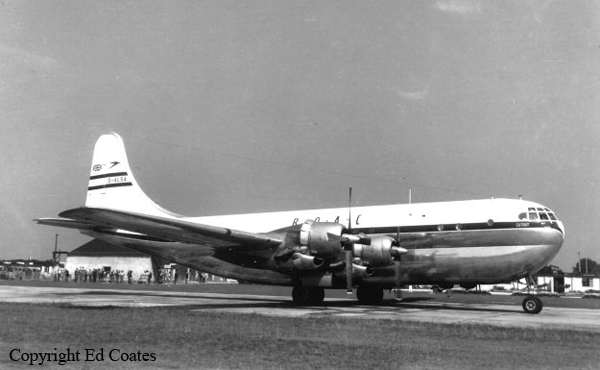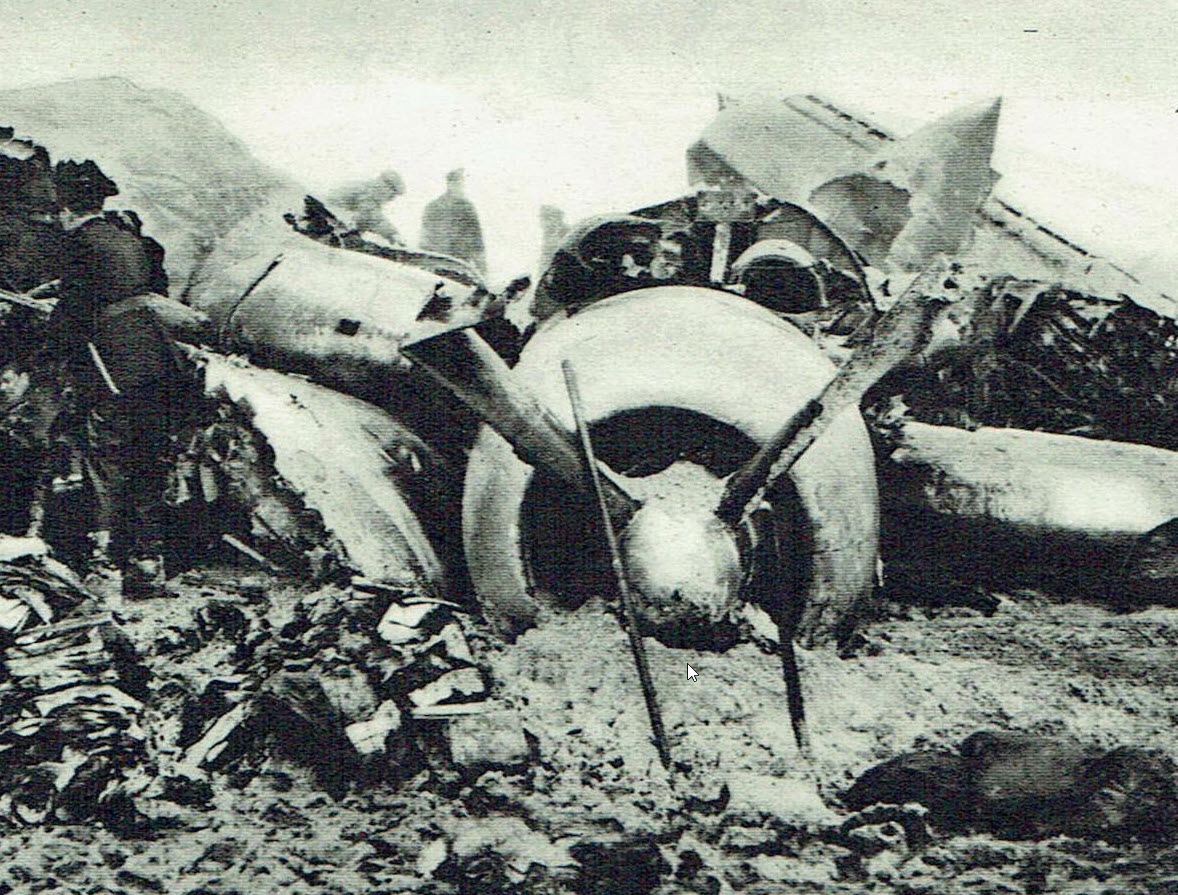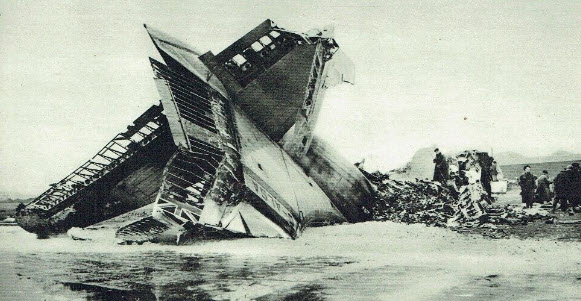Country
Operator Image
Crash of a Boeing 707-465 in London: 5 killed
Date & Time:
Apr 8, 1968 at 1535 LT
Registration:
G-ARWE
Survivors:
Yes
Schedule:
London - Zurich - Tel Aviv - Tehran - Bombay - Singapore - Sydney
MSN:
18373/302
YOM:
1962
Flight number:
BA712
Crew on board:
11
Crew fatalities:
Pax on board:
116
Pax fatalities:
Other fatalities:
Total fatalities:
5
Captain / Total hours on type:
1555.00
Copilot / Total hours on type:
2829
Aircraft flight hours:
20870
Circumstances:
The aircraft was operating Flight BA. 712 from Heathrow Airport, London to Zurich with onward routing to Sydney, Australia. In addition to the normal crew complement, a check pilot was on the aircraft for the purpose of carrying out a route check on the pilot-in-command. The aircraft became airborne from Runway 28 Left at 1527 hours GMT and 20 seconds later, just before the time for the noise abatement power reduction, the flight crew felt and heard a combined shock and bang. The thrust lever for No. 2 engine "kicked" towards the closed position and at the same time the instruments showed that the engine was running down. The pilot-in-command ordered "Engine Failure Drill" and the flight engineer began the immediate actions of that drill. Because the undercarriage was retracted, the warning horn sounded when the flight engineer fully retarded the thrust lever; the check pilot and flight engineer simultaneously went for and pulled the horn cancel switch on the pedestal whilst the co-pilot, instinctively, but in error, pressed the fire bell cancel button in front of him. The flight engineer went for the engine fire shut-off handle but he did not pull it. The lack of a flight deck voice recorder makes it impossible to establish a second by second timing of events, but at about this time the check pilot looked out of a flight deck window on the port side and reported a serious fire in No. 2 engine, adding words to the effect that a landing should be made at the earliest possible moment. No member of the flight crew recalls hearing the fire warning bell. Nevertheless, the fire warning light in No. 2 fire shut-off handle was seen to be on and the pilot-in-command ordered an "Engine Fire Drill". The check pilot suggested, and the co-pilot with the pilot-in-command's approval broadcast, a "Mayday" call. Having initially started an engine failure drill, the flight engineer changed directly to the engine fire drill. According to his evidence, having completed Phase 1 of the engine fire drill, which is required to be done by memory, he subsequently used his own copy of the checklist to complete Phase I1 of the drill, including the operation of the fire extinguisher transfer switch and pushing the discharge button for the second shot thirty seconds after the first. When the co-pilot started to read the check list the flight engineer told him the check was already completed. During this period and subsequently, according to his evidence, the check pilot directed his attention to monitoring the state of the fire on the wing and to providing the pilot-in-command with comments intended to help him position the aircraft for the landing. ATC originally offered the pilot-in-command a landing back on Runway 28L and alerted the fire services but after the "Mayday" call he was offered Runway 05 R which was accepted as it would resulting a shorter flight path. ATC ordered other landing aircraft to overshoot in order to ensure a clear approach to Runway 05 R and to clear Runway 28R for the passage of the fire vehicles. The initial notification to the Airport Emergency Services of the expected landing on Runway 28 L was also revised. About 14 minutes after the start of the fire, No. 2 engine, together with part of its pylon, became detached and fell into a waterfilled gravel pit. This was unknown to the flight crew but because of the separation the light in the fire handle would have gone out. Nevertheless, they were aware that a serious fire continued to burn. At various places along the flight path a number of engine fragments and pieces of cowling had already fallen away, but these caused no injury to persons or damage to property. At about the time the engine fell away the undercarriage was lowered and full flap selected. The undercarriage locked down normally but the hydraulic pressure and contents were seen to fall and the flaps stopped extending at 470, that is 30 short of their full range. The approach to Runway 05 R was made from a difficult position, the aircraft being close to the runway and having reached a height of about 3 000 ft and a speed of 225 kt. There is no glide slope guidance to this runway but the approach was well judged and touchdown was achieved approximately 400 yards beyond the threshold. To add to the pilot-in-command's difficulties, during the final approach the flight engineer informed him that the instruments of No. 1 engine indicated that it might fail, although it did not do so. In order to bring the aircraft to a stop in the shortest possible distance after landing, in addition to the wheel. brakes, reverse thrust from No. 1 and No. 4 engines was used down to a very low speed. The use of reverse thrust caused the flames to be deflected in towards the fuselage. The aircraft came to a stop just to the left of the runway centre line, about 1 800 yards from the threshold, on a heading of 0350M. After the aircraft came to rest the flight engineer commenced the engine shut-down drill and closed the start levers. Almost simultaneously the pilot-in-command ordered fire drill on the remaining engines. Before this could be carried out there was an explosion from the port wing which increased the intensity of the fire and blew fragments of the wing over to the starboard side of the aircraft. The pilot-in-command then ordered immediate evacuation of the flight deck. The engine fire shut-off handies were not pulled and the fuel booster pumps and main electrical supply were not switched off. There were more explosions and fuel, which was released from the port tanks, spread underneath the aircraft and greatly enlarged the area of the fire. The cabin crew had made preparations for an emergency landing and as the aircraft came to a stop opened the emergency exits and started rigging the escape chutes. The passengers commenced evacuation from the two starboard overwing exits and shortly afterwards, when the escape chutes had been inflated, from the rear starboard galley door and then the forward starboard galley door. However, because of the spread of the fire under the rear of the fuselage the escape chute at the rear galley door soon burst and, following the first explosion, the overwing escape route also became unusable. The great majority of the survivors left the aircraft via the forward galley door escape chute. The co-pilot, who could not get into the galley to help with the evacuation, left the aircraft through the starboard flight deck window by use of the escape rope at that position. The Second Officer, who helped guide the passengers in the initial stages, followed, the pilot-in-command, having assisted the stewardess to inflate the port forward chute, also left by the flight deck window after seeing the evacuation was proceeding satisfactorily. The flight engineer saw that the port forward chute had not inflated properly so he climbed down it to straighten it. However, immediately after it inflated it became unusable from heat and burst. The evacuation of passengers had been largely completed by the time the airport fire and rescue services began to provide assistance. The fire services prevented the fuel in the starboard tanks from catching fire but the rear fuselage and port wing were burned out. Four of the passengers and one stewardess were overcome by heat and smoke at the rear of the aircraft and did not escape, whilst thirty-eight passengers sustained . injuries during the evacuation. Some hours after the accident it was not known how many had escaped alive or had been injured because some survivors were quickly removed to various treatment and rest centres whilst others left the vicinity of the airport without leaving their names.
Probable cause:
The accident resulted from an omission to close the fuel shut-off valve when No. 2 engine caught fire following the failure of its No. 5 low pressure compressor wheel. The failure of the wheel was due to fatigue. The following findings were reported:
- The number 2 engine fifth stage low pressure compressor wheel failed due to fatigue. The reason for this has not been established,
- The failure of the No. 2 engine compressor wheel caused damage to the starboard side of the engine and to its cowling. This resulted in a fuel leak from the engine fuel supply line and a fire,
- After starting and before completing an engine overheat or failure drill, it became necessary for the crew to carry out a fire drill,
- The co-pilot cancellation of the fire bell instead of the undercarriage warning horn prevented the fire bell from ringing,
- The closure of the fuel shut-off valve by pulling the fire handle was inadvertently omitted by the flight engineer when he carried out the fire drill. The omission was not noticed by the pilot-in-command, the co-pilot or the Check pilot. The Second Officer was in no position to observe the situation,
- The failure to close the fuel shut-off valve permitted the fire to continue,
- The BOAC fire and engine overheat or failure drills in force at the time were capable of misapplication under stress,
- The overall efficiency of the airport fire service was seriously reduced by some appliance deployment and equipment failures. However, they were successful in preventing the spread of the fire to 3 000 gallons of fuel in the starboard wing of the aircraft
- The number 2 engine fifth stage low pressure compressor wheel failed due to fatigue. The reason for this has not been established,
- The failure of the No. 2 engine compressor wheel caused damage to the starboard side of the engine and to its cowling. This resulted in a fuel leak from the engine fuel supply line and a fire,
- After starting and before completing an engine overheat or failure drill, it became necessary for the crew to carry out a fire drill,
- The co-pilot cancellation of the fire bell instead of the undercarriage warning horn prevented the fire bell from ringing,
- The closure of the fuel shut-off valve by pulling the fire handle was inadvertently omitted by the flight engineer when he carried out the fire drill. The omission was not noticed by the pilot-in-command, the co-pilot or the Check pilot. The Second Officer was in no position to observe the situation,
- The failure to close the fuel shut-off valve permitted the fire to continue,
- The BOAC fire and engine overheat or failure drills in force at the time were capable of misapplication under stress,
- The overall efficiency of the airport fire service was seriously reduced by some appliance deployment and equipment failures. However, they were successful in preventing the spread of the fire to 3 000 gallons of fuel in the starboard wing of the aircraft
Final Report:
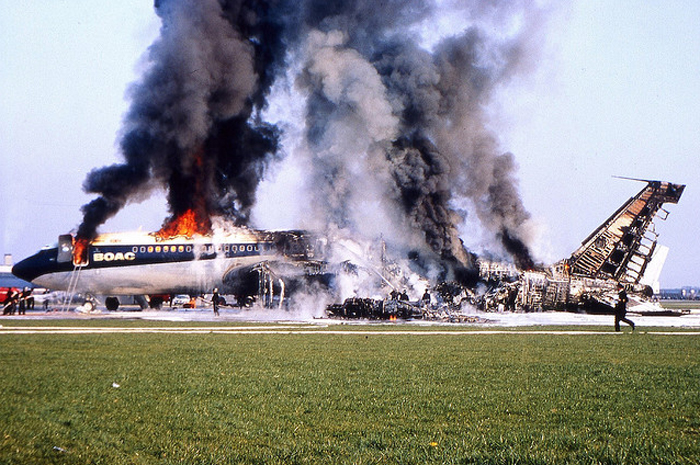
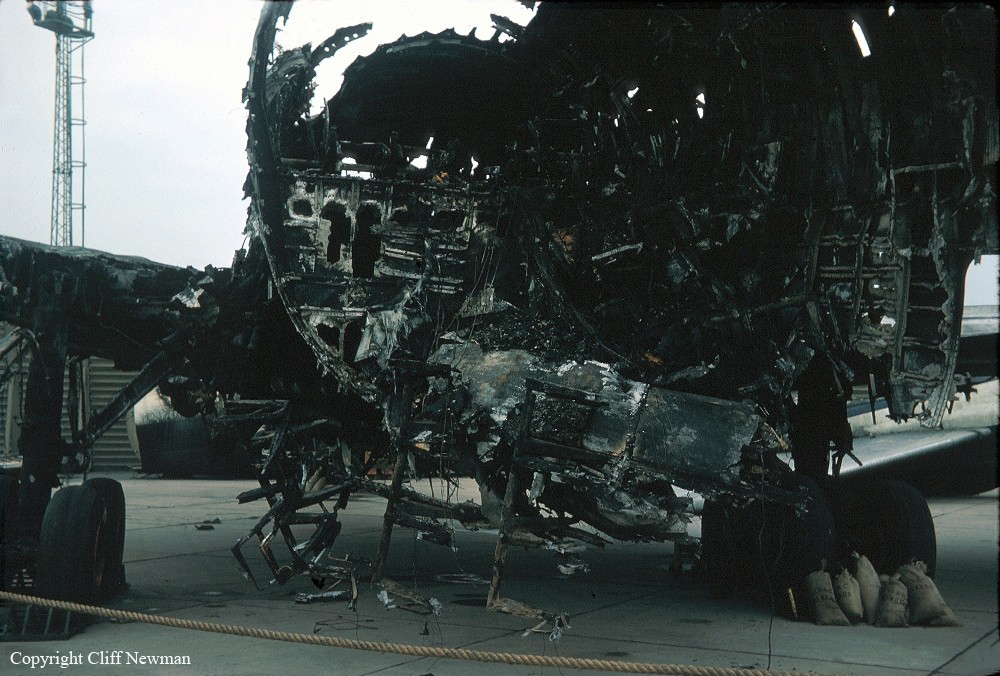
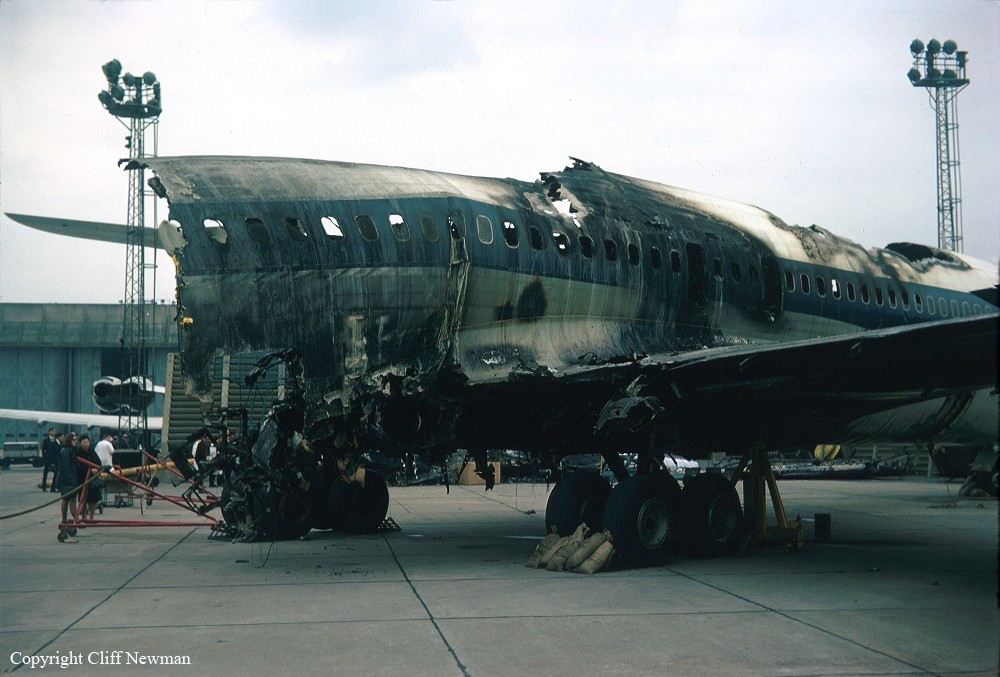
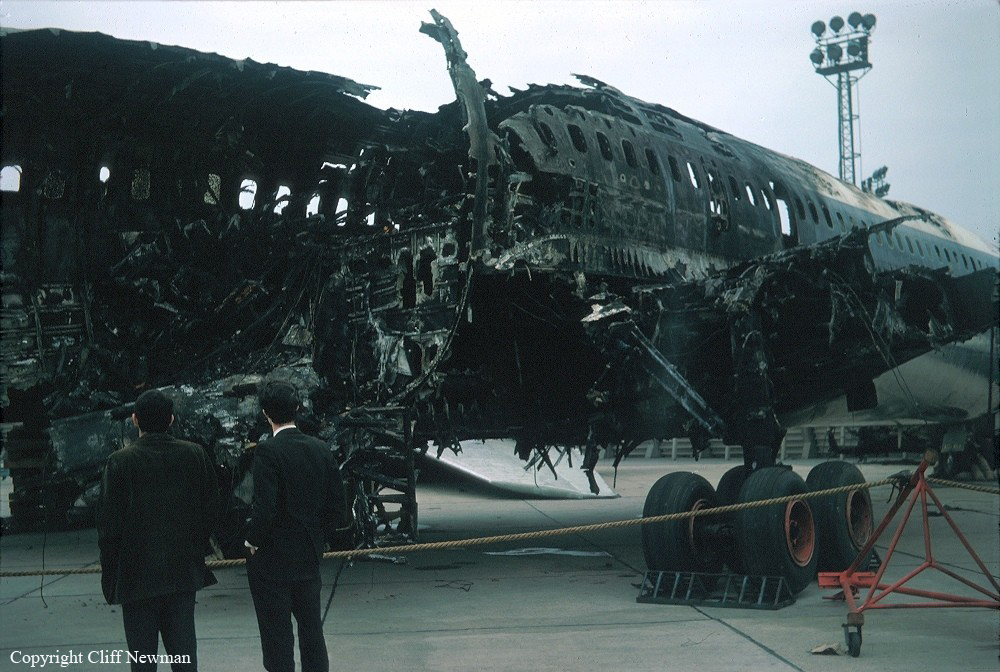
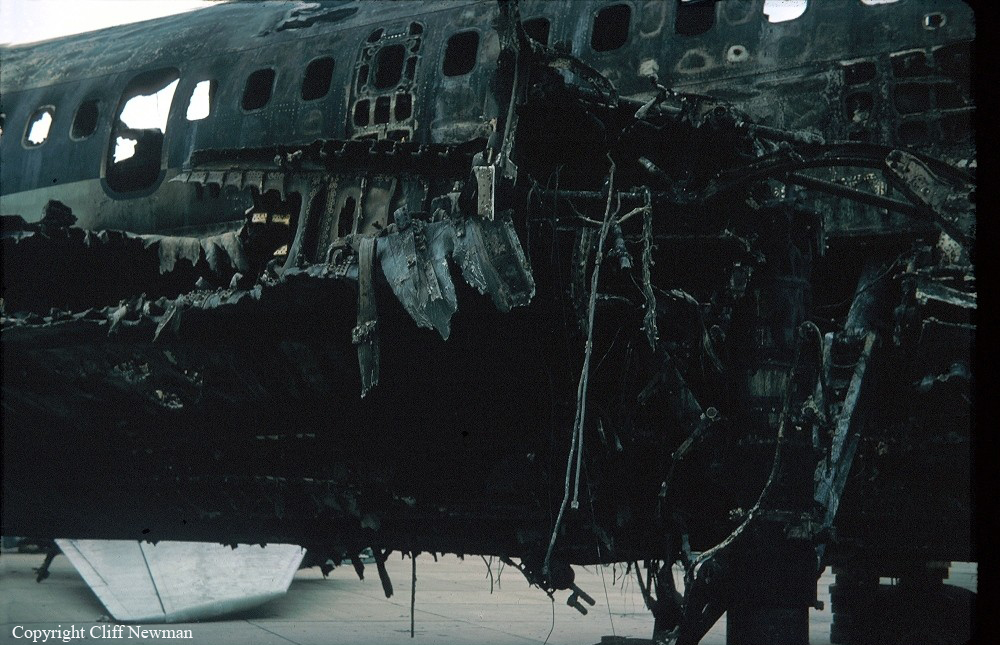
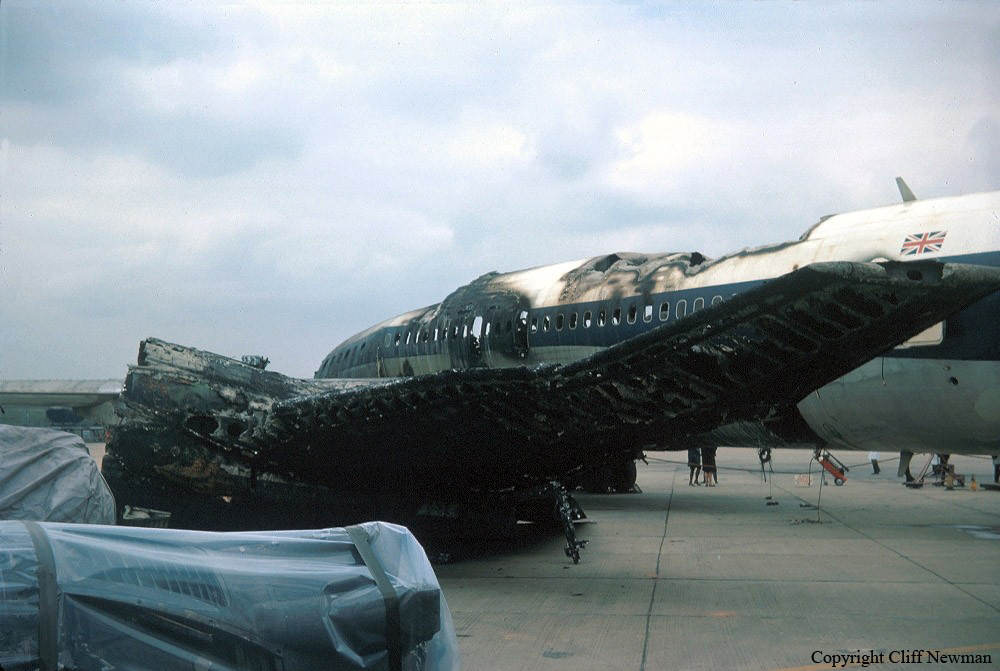
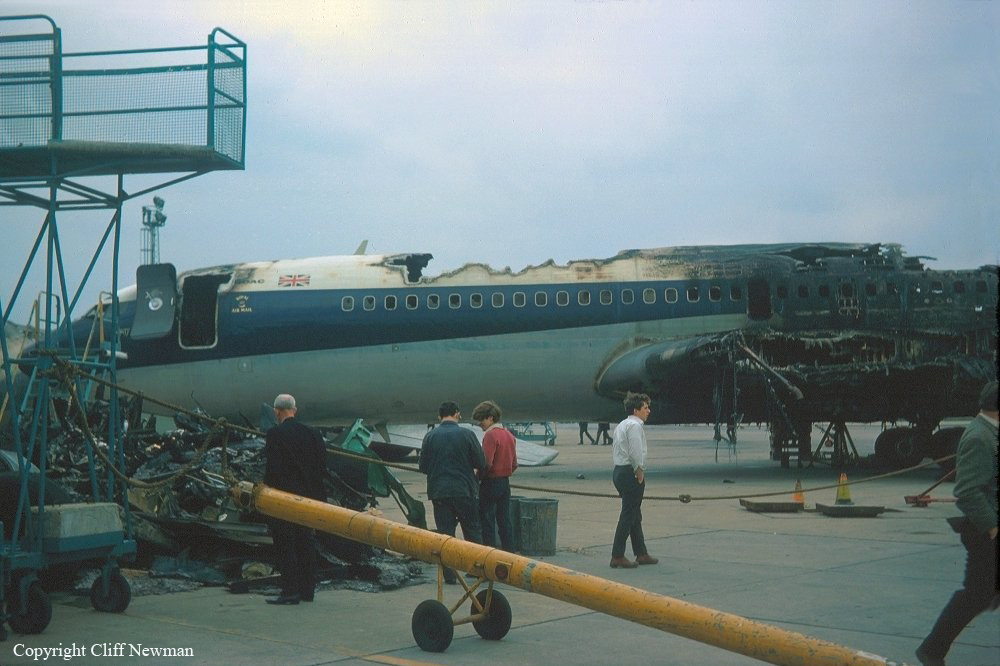









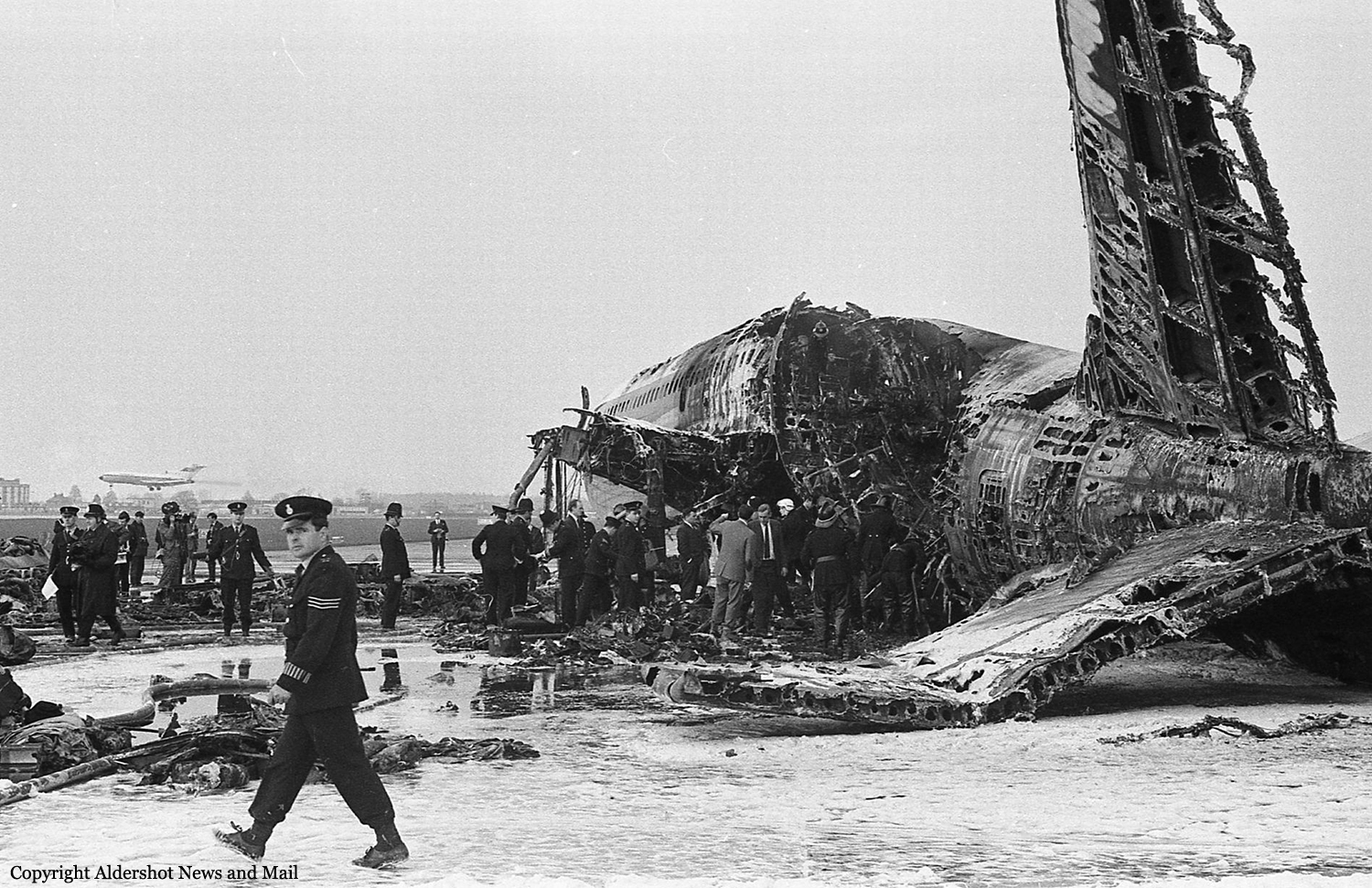

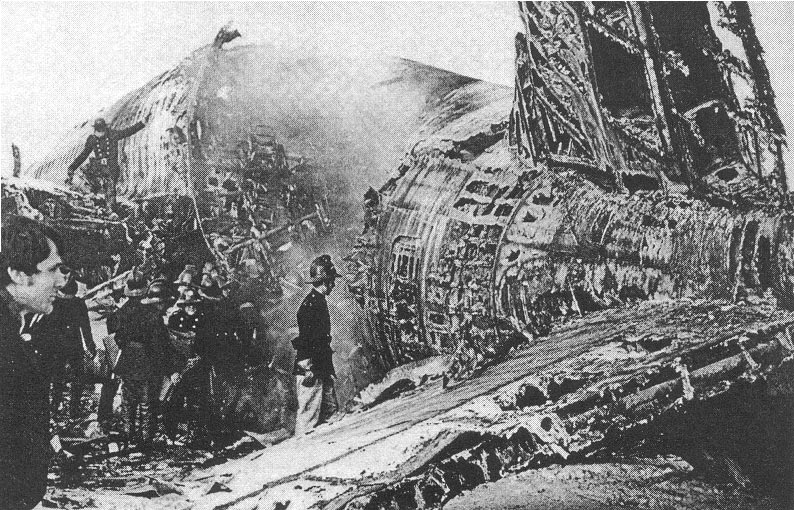
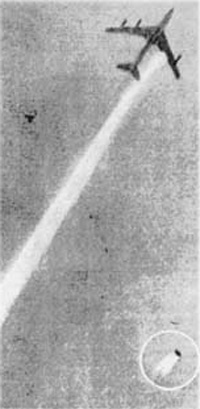
Crash of a Boeing 707-436 on Mt Fuji: 124 killed
Date & Time:
Mar 5, 1966 at 1415 LT
Registration:
G-APFE
Survivors:
No
Schedule:
San Francisco – Honolulu – Tokyo – Hong Kong – London
MSN:
17706
YOM:
1960
Flight number:
BA911
Crew on board:
11
Crew fatalities:
Pax on board:
113
Pax fatalities:
Other fatalities:
Total fatalities:
124
Captain / Total hours on type:
2155.00
Copilot / Total hours on type:
2073
Aircraft flight hours:
19523
Aircraft flight cycles:
6744
Circumstances:
BOAC Flight 911 was a scheduled service from San Francisco (SFO) to Hong Kong (HKG) via Honolulu (HNL) and Tokyo (HND). The Boeing 707 was expected to arrive at Tokyo Airport at 16:45 on 4 March. However, due to poor meteorological conditions at Tokyo and because the precision approach radar (PAR) of the GCA was out of service, it diverted to Fukuoka (FUK) and landed there at 18:00. After staying overnight at Fukuoka, Flight 911 left for Tokyo at 11:25 and landed there at 12:43. The aircraft was prepared for the next leg to Hong Kong and a flight plan was filed for a flight in accordance with the instrument flight rules via Oshima on airway JG6 to Hong Kong at FL310. At 13:42 hours the crew contacted ATC requesting permission to start the engines and clearance for a VMC climb via Fuji-Rebel-Kushimoto. The aircraft left the ramp at 13:50. It was instructed to make "a right turn after take off", and departed Tokyo Airport at 13:58. After takeoff the aircraft flew over Gotemba City on a heading of approximately 298 deg at an altitude of approximately 4900 m and indicated airspeed of 320 to 370 knots. The aircraft, trailing white vapor, then suddenly lost altitude over the Takigahara area, and parts of the aircraft began to break away over Tsuchiyadai and Ichirimatsu. Finally over Tarobo at an altitude of approx. 2000 m, the forward fuselage broke away. The mid-aft fuselage together with the wing, making a slow flat spin to the right, crashed into a forest at the foot of Mount Fuji. The forward fuselage crashed into the forest approx. 300 m to the west of the above site and caught fire. All 124 occupants were killed.
Probable cause:
The aircraft suddenly encountered abnormally severe turbulence over Gotemba City which imposed a gust load considerably in excess of the design limit.
Final Report:
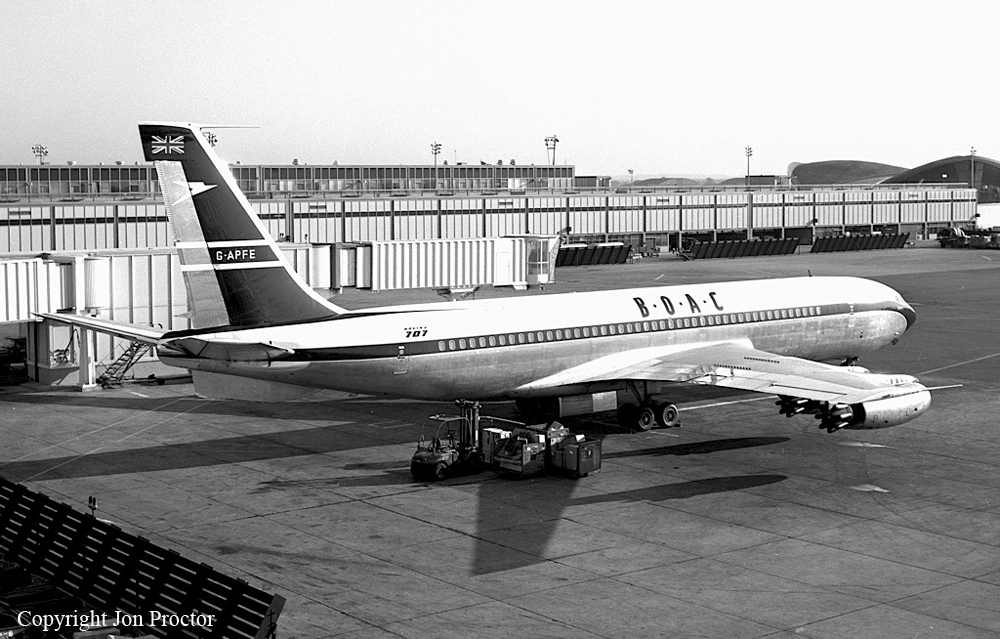
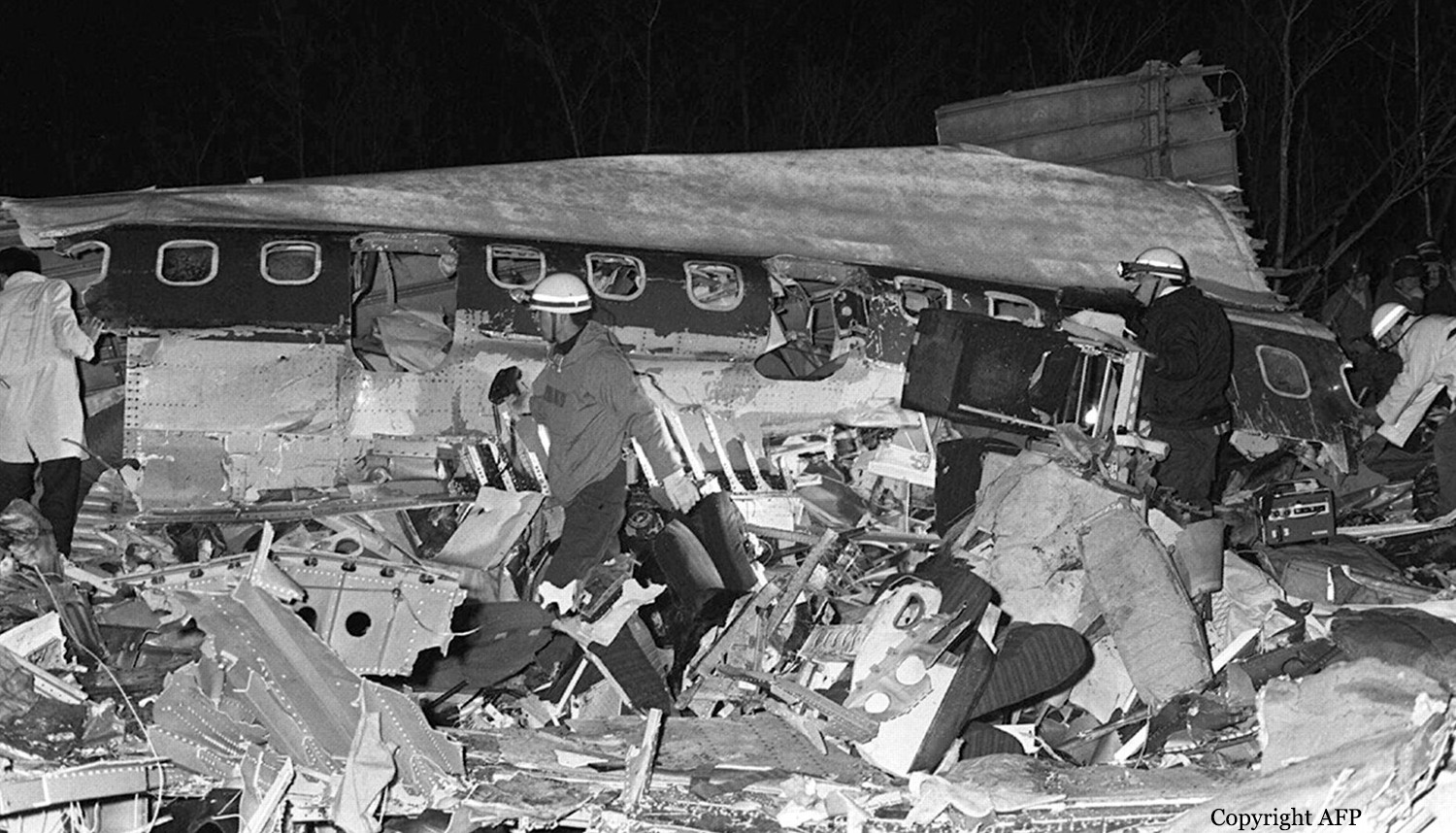
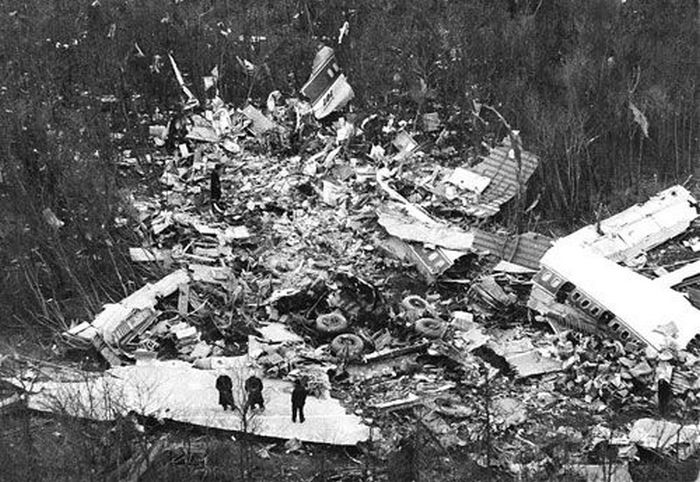
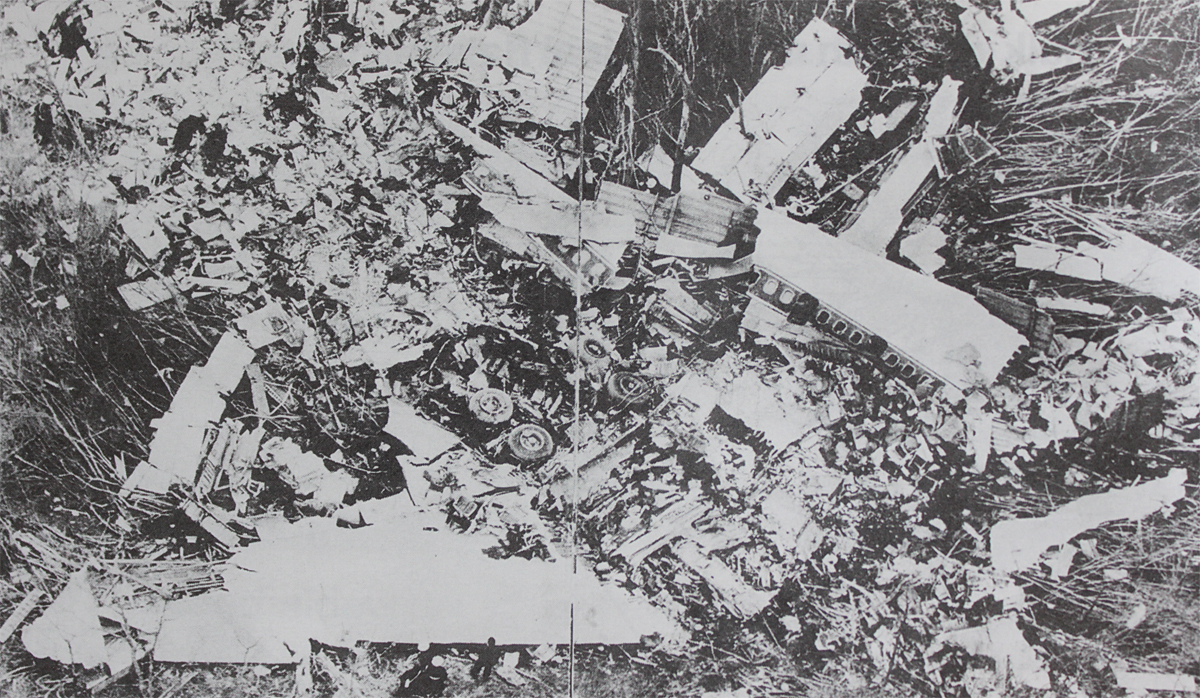
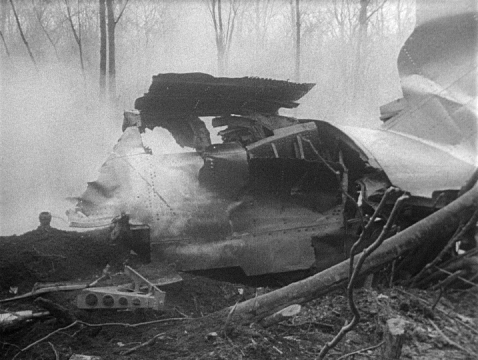
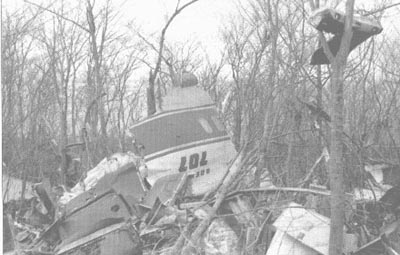
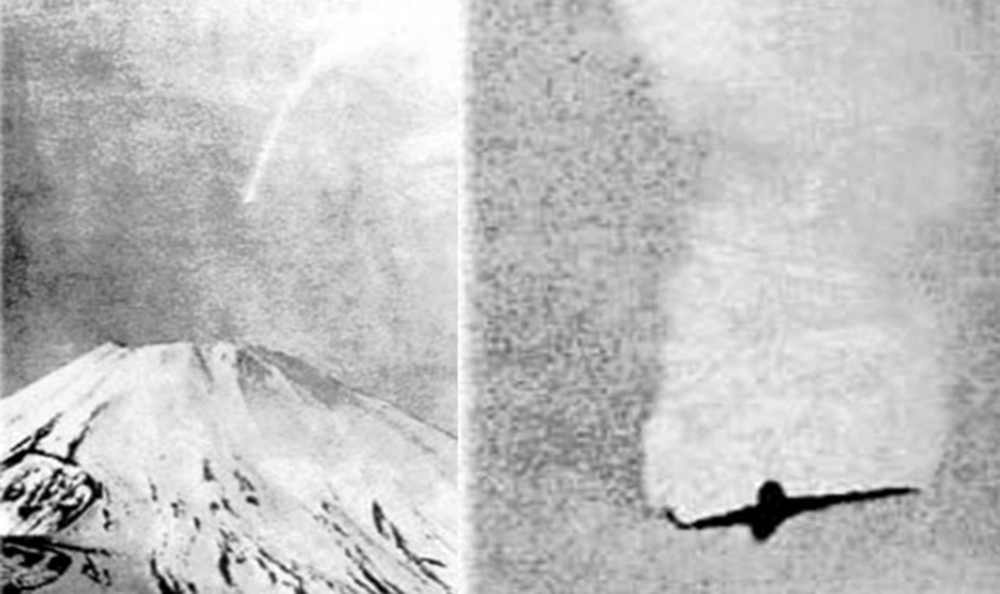
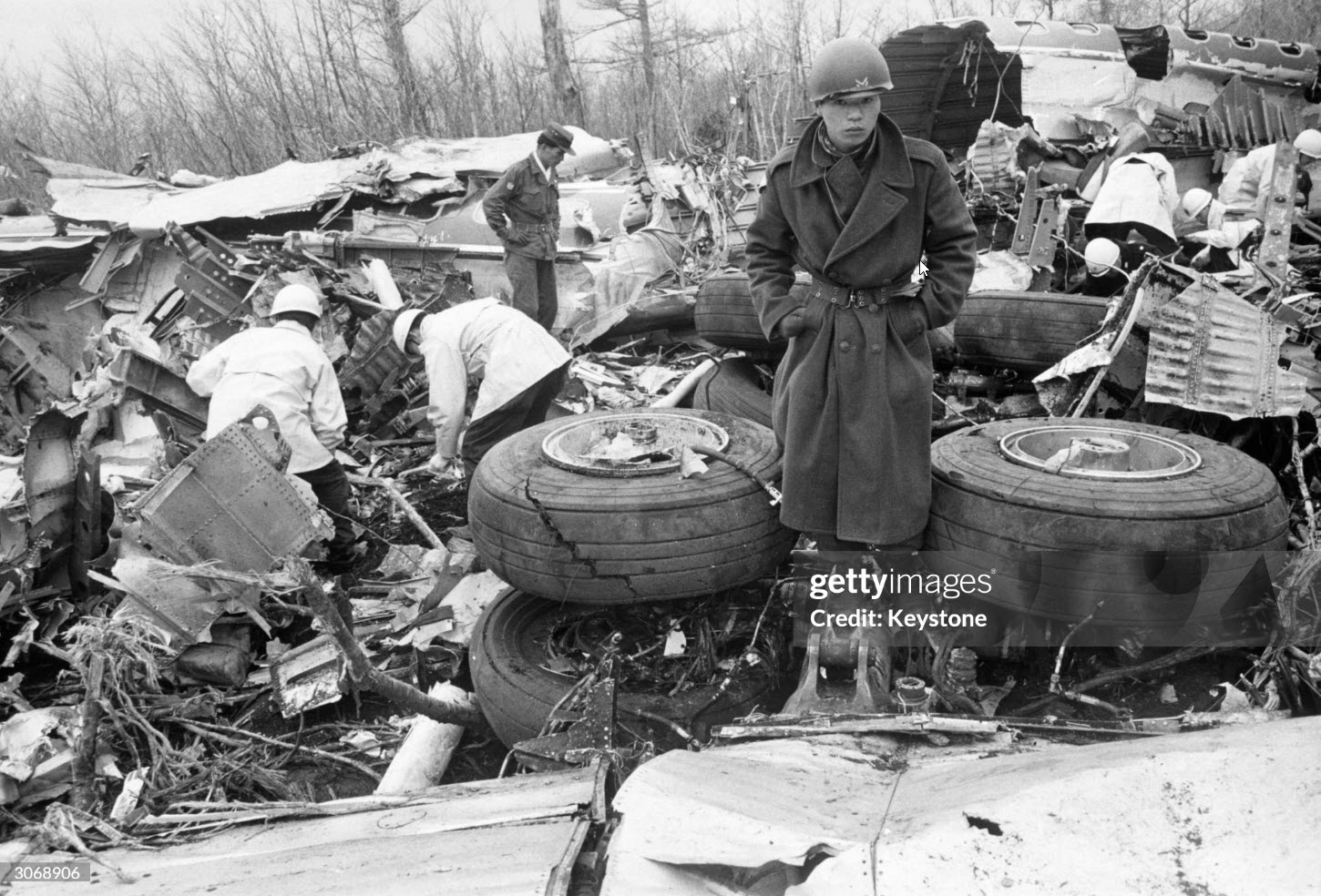
Crash of a Bristol 175 Britannia 102 in Khartoum
Date & Time:
Nov 11, 1960
Registration:
G-ANBC
Survivors:
Yes
Schedule:
London – Cairo – Khartoum
MSN:
12904
YOM:
1955
Crew on board:
9
Crew fatalities:
Pax on board:
18
Pax fatalities:
Other fatalities:
Total fatalities:
0
Circumstances:
En route from Cairo to Khartoum at an altitude of 20,500 feet, a loss of hydraulic pressure occurred. The crew continued the flight and started the descent to Khartoum. While completing the approach checklist, the crew was unable to lower the landing gear, even with the emergency systems. The captain decided to complete a belly landing on the sandy area alongside the runway. The airplane slid for hundreds yards before coming to rest. All 27 occupants were evacuated safely while the aircraft was damaged beyond repair.
Probable cause:
It was determined that the failure of the support member for the starboard main gear uplock caused the gear to fall in flight, damaging hydraulic system lines.
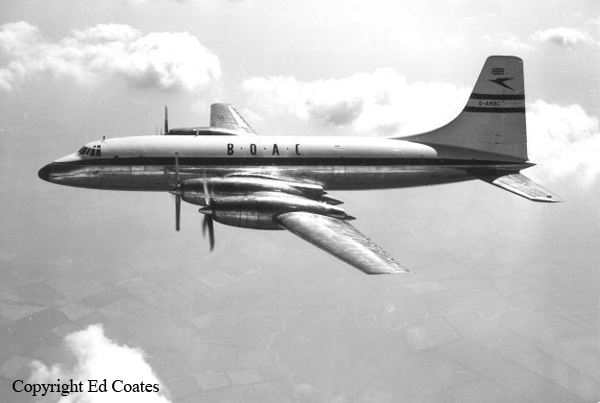
Crash of a Bristol 175 Britannia 312 in Winkton: 9 killed
Date & Time:
Dec 24, 1958 at 1158 LT
Registration:
G-AOVD
Survivors:
Yes
Schedule:
London - London
MSN:
13235
YOM:
1957
Crew on board:
3
Crew fatalities:
Pax on board:
9
Pax fatalities:
Other fatalities:
Total fatalities:
9
Circumstances:
The airplane departed London-Heathrow Airport at 1010LT on a test flight regarding the renewal of its Certificate of Airworthiness. After performing the necessary test, the crew requested a descent from 12,000 feet to 3,000 feet. Three minutes after starting the descent, while cruising in a visibility reduced by fog, the aircraft struck the ground and crashed in a field located in Winkton, southeast of Bournemouth-Hurn Airport. Seven occupants were killed while three others were seriously injured. The aircraft disintegrated on impact.
Probable cause:
The accident was the result of the aircraft being flown into ground obscured by fog. This was caused by a failure on the part of both the captain and the first officer to establish the altitude of the aircraft before and during the final descent. The responsibility for the accident must rest with the captain. The height presentation afforded by the type of three-pointer altimeter fitted to the subject aircraft was such that a higher degree of attention was required to interpret it accurately than is desirable in so vital an instrument. This, when taken into conjunction with the nature of the flight on which the aircraft was engaged was a contributory factor.
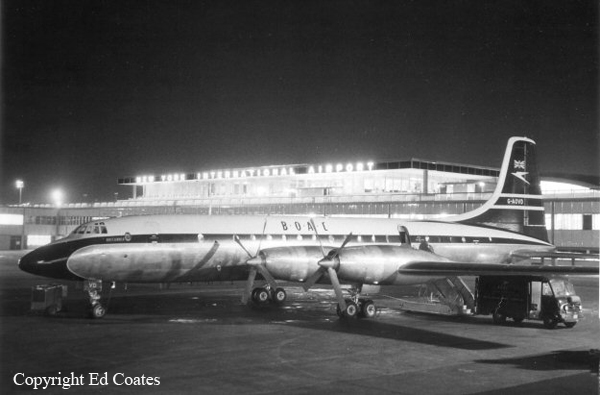
Crash of a Canadair C-4M Argonaut in Kano: 32 killed
Date & Time:
Jun 24, 1956 at 1722 LT
Registration:
G-ALHE
Survivors:
Yes
Schedule:
Lagos – Kano – Tripoli – London
MSN:
151
YOM:
1949
Crew on board:
7
Crew fatalities:
Pax on board:
38
Pax fatalities:
Other fatalities:
Total fatalities:
32
Circumstances:
The four engine aircraft departed runway 25 at Kano Airport for Tripoli in moderate rain and climbed to an altitude of 250 feet. The aircraft then began to lose height rapidly and although the pilot-in- command ordered full power, the descent could not be checked. Notwithstanding the increased power he was unable to prevent it striking a tree and the aircraft crashed about 1,5 mile from the end of the runway. Three crew members and 29 passengers were killed. At time of takeoff, the reported weather conditions on runway 25 were as follows: cloud 3/8, base at 2,500 feet, wind 270° at 20 knots, visibility 1,500 yards and moderate rain.
Probable cause:
The accident was the result of loss of height and airspeed caused by the aircraft en- countering, at approximately 250 feet after takeoff, an unpredictable thunderstorm cell which gave rise to a sudden reversal of wind direction, heavy rain, and possible downdraught conditions.
Final Report:
Crash of an Avro 685 York C.1 in Idris
Date & Time:
Apr 22, 1956
Registration:
G-AGNS
Survivors:
Yes
MSN:
1220
YOM:
1945
Crew on board:
0
Crew fatalities:
Pax on board:
0
Pax fatalities:
Other fatalities:
Total fatalities:
0
Circumstances:
Suffered a ground accident at Idris Airport prior to takeoff. There were no casualties but the aircraft was written off.
Crash of a De Havilland DH.104 Dove 2 at London-Heathrow
Date & Time:
Dec 9, 1955 at 2152 LT
Registration:
G-ALTM
Survivors:
Yes
Schedule:
London-Heathrow - London-Heathrow
MSN:
04236
YOM:
1949
Crew on board:
1
Crew fatalities:
Pax on board:
2
Pax fatalities:
Other fatalities:
Total fatalities:
0
Circumstances:
The aircraft was carrying two filmmakers and one pilot who were in charge to make a movie of the Heathrow Airport. Following an uneventful mission, the pilot returned to the airport when, on final approach, the right engine suffered technical problems and failed. In a certain confusion, the pilot mistakenly shut down the left engine, causing the aircraft to stall and to crashed short of runway. All three occupants were evacuated while the aircraft was written off.
Probable cause:
Failure of the right engine on final approach and wrong engine shut down by the pilot.
Crash of a Canadair C-4M Argonaut in Tripoli: 15 killed
Date & Time:
Sep 22, 1955 at 0023 LT
Registration:
G-ALHL
Survivors:
Yes
Schedule:
London – Rome – Tripoli – Kano – Lagos
MSN:
158
YOM:
1949
Crew on board:
7
Crew fatalities:
Pax on board:
40
Pax fatalities:
Other fatalities:
Total fatalities:
15
Circumstances:
On approach to Tripoli Airport by night and poor weather conditions, the crew was unable to locate the runway and decided to make a go around. Three times, the captain decided to abandon the approach procedure for a go around maneuver. During a fourth attempt, he descended below the glide when the aircraft hit trees and crashed 1,200 yards short of runway 11. Two crew members and 13 passengers were killed and the aircraft was destroyed. All other occupants were injured.
Probable cause:
The accident was the result of an error of judgement on the part of the captain who having made three unsuccessful attempts to line-up and land on runway 11 on his fourth attempt allowed his desire to keep the runway lights in view to affect his judgement, in that during a visual approach to the runway he failed to make adequate reference to his flight instruments. In the restricted visibility the runway lights gave him insufficient guidance as to attitude, height and angle of approach and unknowingly he permitted the aircraft to descend below its correct approach path.
Final Report:
Crash of a Boeing 377-10-28 Stratocruiser in Prestwick: 28 killed
Date & Time:
Dec 25, 1954 at 1200 LT
Registration:
G-ALSA
Survivors:
Yes
Schedule:
London – Prestwick – Shannon – Gander – New York
MSN:
15943
YOM:
1949
Crew on board:
11
Crew fatalities:
Pax on board:
25
Pax fatalities:
Other fatalities:
Total fatalities:
28
Circumstances:
The flight from London to Prestwick was uneventful. Throughout the flight the captain kept in touch with the weather conditions and Prestwick Approach Control received the aircraft about 0248 hours. Preceding the aircraft by approximately four minutes in arrival at Prestwick was a Constellation, and these two aircraft were fed into the stack at Prestwick; the Constellation at 4 000 feet and the Stratocruiser at 5 000 feet. The runway to be used was Runway 31 which required the approach to be made from the southeast. The Instrument Landing System (hereinafter called ILS) without the Glide Path and the Ground Control Approach system (hereinafter called GCA) were available on Runway 31. G. C.A. took over the Stratocruiser about 0314 hours and at 0323 hours the talk-down controller 'took over the aircraft. Meantime Meteorological Reports had been passing from ground to air. The talk-down was completed at 0325 hours when the aircraft was 400 yards from the threshold of Runway 31. The approach up to this point had been high but uneventful. A few seconds later the aircraft struck the ground 127 feet short of the threshold of Runway 31, sustaining some damage. It then ran on to the runway and proceeded for some 90 feet where it was again airborne for another 400 feet. It then contacted the runway and sustained considerable damage, and came to rest with the passenger compartment in an inverted position on the south side of the runway about 550 yards from the threshold. Except for the front portion of the fuselage which lay on its port side, severe damage resulted from fire which broke out and spread rapidly, due probably to the partial detachment of the port wing and rupture of the fuel tanks. From the accident there survived seven of the crew and one passenger.
Probable cause:
The accident was the result of errors of judgment on the part of the captain in:
- starting his final approach to land at too steep an angle and,
- flaring out too late and too severely with the result that the aircraft sank and hit the ground short of the runway. During the flare out the aircraft passed through low cloud, thus reducing the captain's visibility. The accident was also contributed to by the failure of the first officer to carry out the order of the captain to put on the landing lights which prevented the captain from observing timeously the low cloud over the approach lights.
- starting his final approach to land at too steep an angle and,
- flaring out too late and too severely with the result that the aircraft sank and hit the ground short of the runway. During the flare out the aircraft passed through low cloud, thus reducing the captain's visibility. The accident was also contributed to by the failure of the first officer to carry out the order of the captain to put on the landing lights which prevented the captain from observing timeously the low cloud over the approach lights.
Final Report:
